Explore Imabari - Japan Travel, Asia
Nestled on the picturesque Shikoku Island in Japan, Imabari is a hidden gem offering a blend of historical charm and natural beauty. This city, known for its rich cultural heritage and stunning landscapes, provides an inviting escape for travelers seeking both adventure and tranquility. Imabari is renowned for its historical landmarks, vibrant local culture, and delectable cuisine, making it an ideal destination for an unforgettable Japanese experience.
Want to elevate your Japan experience? Check out our collection of premium tours here for an exceptional journey.
Population: Approximately 152,000 in 2022.
Economy: Home of Imabari Shipbuilding, Japan’s largest ship builder, and many other maritime servicing facilities along the coast.
Landmarks: Famous for the Imabari Castle, Kurushima-Kaikyo Bridge, and Takanawa Mountain.
Japan
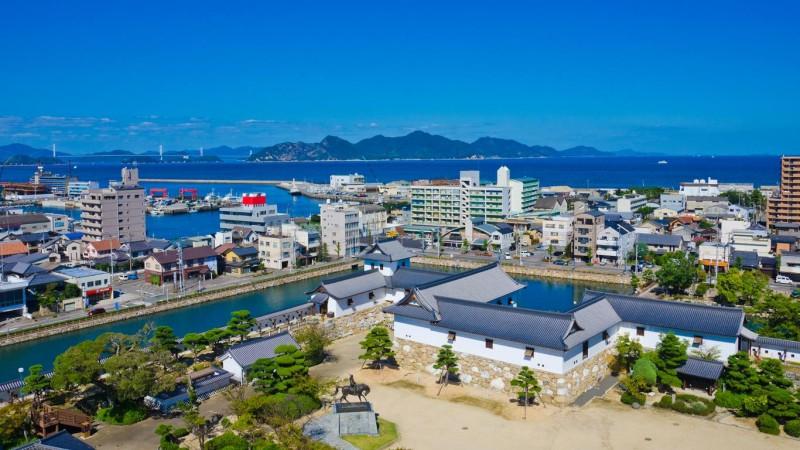
Overview of Imabari
History & Cultural Influence
Imabari's history dates back to ancient Japan, with significant development during the samurai era. The city's strategic location made it a crucial hub during feudal times, leading to the construction of iconic landmarks of the samurai heritage, the Imabari Castle. Today, the castle serves as a major historical attraction, drawing visitors who wish to delve into Japan’s rich feudal history. Imabari is also celebrated for its traditional arts and crafts, particularly its famous Imabari towels, which are known for their exceptional quality and softness. The influence of local traditions is evident in various cultural practices, from seasonal festivals to artisanal workshops. These cultural elements, deeply rooted in the city’s history, offer travelers a unique glimpse into Imabari’s vibrant heritage.
Interaction with the Locals
Imabari, located on Shikoku Island, Japan, has a population of approximately 152,000 residents. The city's citizens are known for their warmth and hospitality, reflecting a strong sense of community. Imabari’s population enjoys a blend of traditional and modern lifestyles, contributing to the city's rich cultural fabric and welcoming atmosphere for visitors.
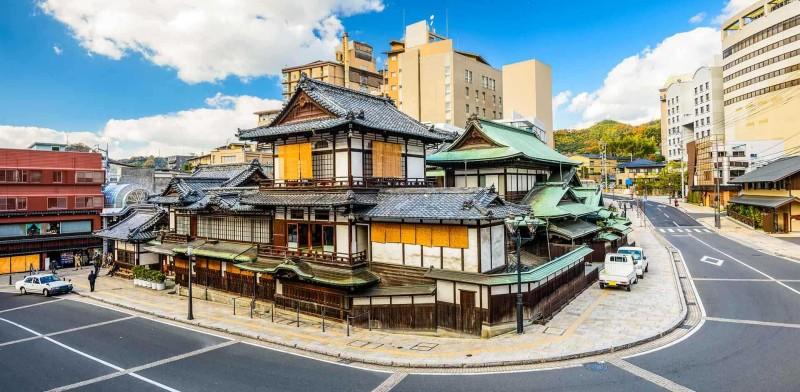
Ancient architecture in Imabari - © Japan Tourism
Top Attractions in Imabari
Imabari holds several must-visit attractions that showcase its historical and natural beauty. Each of these sites highlights different facets of Imabari’s charm, from historical significance to natural splendor. Exploring these sites provides a comprehensive view of what makes this city a unique destination.
- Imabari Castle: This majestic fortress is a prime example of Japan’s feudal architecture. With its imposing stone walls and beautifully landscaped gardens, the castle offers a fascinating journey into the past. Visitors can explore the museum within the castle and enjoy panoramic views from the top.
- Kurushima-Kaikyo Bridge: Spanning the narrow strait between Shikoku and Honshu, this engineering marvel provides breathtaking views of the surrounding islands and ocean. The bridge is particularly impressive when lit up at night, offering a spectacular sight for travelers.
- Takanawa Mountain: For those seeking natural beauty, Mount Takanawa offers scenic hiking trails and serene landscapes. For those who love the outdoors and want to get away from the hustle and bustle of the city, Imabari's mountain paths are ideal.
- Bisan-Seto National Park: This breathtaking national park offers a wide variety of scenery, such as rocky beaches, serene bays, and thick woods. Visitors can enjoy picturesque walking trails, scenic viewpoints, and the unique tidal flats that reveal a different aspect of Imabari’s natural beauty.
- Gokase Gorge: Known for its crystal-clear waters and dramatic rock formations, Gokase Gorge is a popular spot for outdoor activities such as kayaking and fishing. The gorge's serene environment provides an ideal setting for relaxation and nature appreciation, making it a hidden gem for those seeking a peaceful retreat.
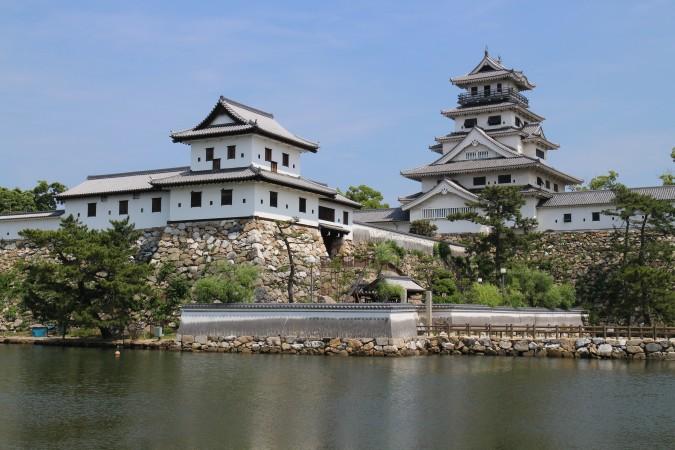
Imabari Castle - © Wikimedia
Must-Try Dishes in Imabari
Imabari’s culinary tradition is a feast for the senses, offering a rich variety of local dishes that highlight the region’s fresh ingredients and traditional flavors.
- Imabari Tamago (Omelet): A local delicacy, Imabari Tamago is a fluffy, sweet omelet often enjoyed as a savory snack or in various dishes. Visitors should definitely try it because of its delicate texture and delicious flavor.
- Kibinago (Silver-stripe Round Herring): This small fish, known for its delicate taste, is often served raw or lightly grilled. It’s a local favorite that reflects Imabari’s maritime heritage.
- Sanuki Udon: While originally from the nearby Kagawa Prefecture, Sanuki Udon is a popular dish in Imabari. These thick, chewy noodles are typically served in a savory broth and topped with various ingredients.
- Imabari Yakisoba: This stir-fried noodle dish features a savory sauce and is often combined with vegetables, pork, or seafood. It is a well-liked street dish that exemplifies comfort cuisine from the area.
- Mikan (Mandarins): Imabari is famous for its sweet and juicy mandarins, known as mikan. These citrus fruits are enjoyed fresh or used in desserts and beverages, offering a refreshing taste of the region.
- Ebi Ten (Shrimp Tempura): Imabari’s shrimp tempura is renowned for its crispy batter and tender shrimp. This dish highlights the local seafood and is a popular choice for both locals and visitors.
- Sukiyaki: This traditional hot pot dish consists of noodles, tofu, vegetables, and thinly sliced beef cooked in a savory-sweet sauce. It’s often enjoyed in local restaurants and offers a hearty and satisfying meal.
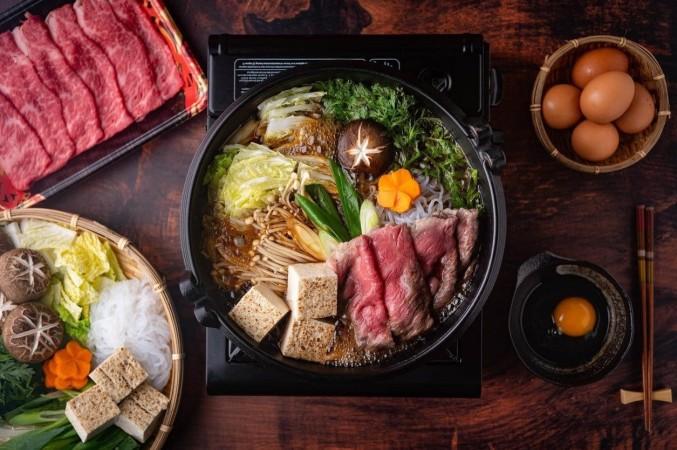
Sukiyaki - © Japanese Taste
Festivals & Local Celebrations
Imabari’s festivals and local celebrations offer vibrant glimpses into the city’s cultural life, filled with traditional practices and community spirit. These festivals provide an engaging way to experience local traditions, offering both locals and visitors an opportunity to participate in and celebrate the city’s rich cultural heritage.
Imabari Taimatsu Festival
Held every August, the Imabari Taimatsu Festival is a spectacular event that lights up the city with its dramatic torch processions. Participants carry large, flaming torches through the streets, creating a mesmerizing display of fire and light. The festival, which dates back to the Edo period, is held to honor local deities and ensure a bountiful harvest. Accompanied by traditional music and dance performances, it’s a captivating experience that offers visitors a deep dive into Imabari’s cultural traditions.
Kurushima-Kaikyo Bridge Illumination
The Kurushima-Kaikyo Bridge, an architectural marvel connecting Shikoku and Honshu, is adorned with stunning lights during special occasions and seasonal events. The illumination of the bridge transforms it into a dazzling spectacle, especially enchanting during the evenings. This event celebrates the bridge’s significance and offers a beautiful visual experience that highlights Imabari’s blend of modernity and tradition.
Imabari Matsuri
Another notable event is the Imabari Matsuri, a traditional festival that takes place in spring. This festival features colorful floats, local music, and dance performances. It’s a lively celebration that brings the community together, showcasing Imabari’s vibrant cultural heritage.
Looking for more adventures? Dive into Mito, another famous destination in Japan, with our article here.
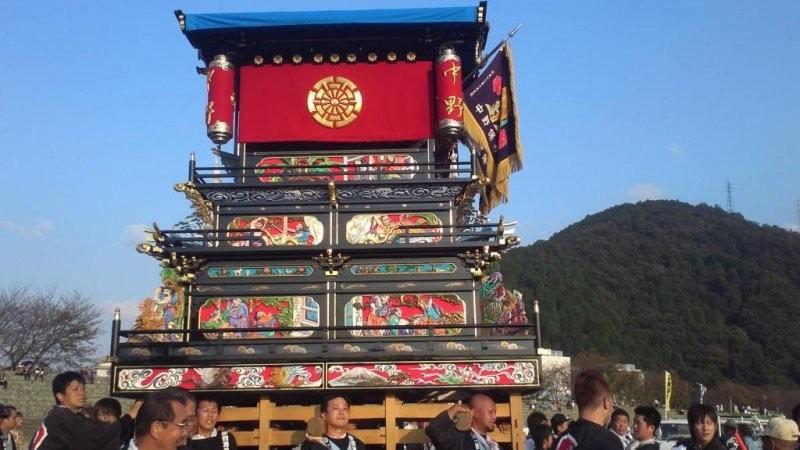
Imabari Matsuri parade - © Japan Tourism
What to Do in Imabari
Imabari offers a range of activities that cater to diverse interests, making it a destination with something for everyone. These activities offer a diverse range of experiences, allowing visitors to explore Imabari’s natural beauty, historical sites, and local culture.
- Shimanami Kaido Cycling Tours: Discover the well-known Shimanami Kaido bicycle path that links Honshu and Shikoku. This scenic bike path offers stunning views of the Seto Inland Sea and picturesque islands, perfect for cycling enthusiasts and nature lovers.
- Seto Sea Boat Tour: Discover Imabari’s beautiful coastal scenery and nearby islands on a relaxing boat tour. Enjoy panoramic views of the Seto Inland Sea and learn about the local maritime environment.
- Participate in Traditional Craft Workshop: Engage in local craftsmanship by participating in workshops such as towel weaving or pottery making. These hands-on experiences provide insight into traditional Japanese arts and offer a chance to create unique souvenirs.
- Hiking Mount Takanawa: Enjoy outdoor adventure by hiking the trails of Mt. Takanawa. The mountain offers scenic views and a chance to experience the natural beauty of Imabari’s lush landscapes.
- Explore Gokase Gorge: Visit Gokase Gorge for a tranquil escape amidst crystal-clear waters and dramatic rock formations. Engage in outdoor activities like kayaking or fishing and appreciate the serene environment.
- Local Markets Food Tours: Experience Imabari’s vibrant markets, where you can sample fresh produce, seafood, and local delicacies. The lively atmosphere and variety of goods provide a taste of the city’s culinary delights.
Shopping in Imabari
Imabari offers a delightful shopping experience, with a variety of places to find local goods, unique souvenirs, and traditional crafts.
- Local Markets: Dive into Imabari’s bustling markets to discover fresh produce, seafood, and local specialties. These vibrant markets offer an authentic taste of the city and a chance to interact with local vendors.
- Imabari Towel Shops: Visit Imabari towels specialty stores during your travel as they are renowned for their exceptional quality and softness. These towels make excellent souvenirs and are a testament to the city’s artisanal craftsmanship.
- Souvenir Shops: For unique gifts and keepsakes, check out Imabari’s souvenir shops. They offer a range of traditional textiles, ceramics, and other locally made items that capture the essence of the city.
- Craft Stores: Explore stores specializing in local crafts and artisanal products. These shops often feature handmade ceramics, textiles, and other crafts that reflect Imabari’s cultural heritage.
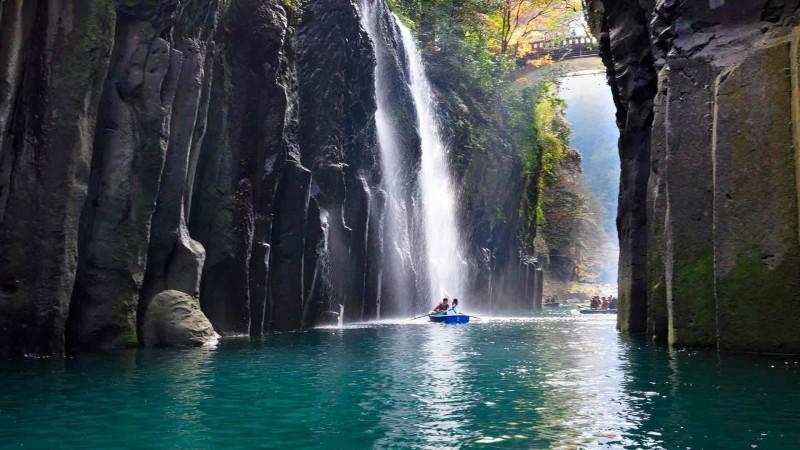
Explore the breathtaking Gokase Gorge - © Japan Tourism
Weather in Imabari: Best Time to Visit
Imabari’s climate varies throughout the year, influencing tourism trends and activities. These seasonal trends highlight the diverse experiences Imabari offers throughout the year, allowing visitors to plan their trips based on their interests and the climate.
Spring in Imabari
Spring brings mild and pleasant feelings, with temperatures ranging from 10°C to 20°C (50°F to 68°F). This is a popular time for tourists to enjoy cherry blossom viewing, outdoor activities and Imabari Taimatsu Festival. The blooming cherry trees create picturesque settings, making it an ideal season for photography, picnics, and strolling through parks and gardens.
Summer in Imabari
Summers are warm and humid, with temperatures often reaching 25°C to 35°C (77°F to 95°F). This season attracts visitors looking to enjoy coastal activities, such as beach outings and boat tours. The high temperatures and humidity make it a great time for water sports and exploring the Seto Inland Sea. It’s also festival season, offering a lively atmosphere.
Autumn in Imabari
Autumn is characterized by gorgeous fall foliage and colder temperatures, which range from 15°C to 25°C (59°F to 77°F). This season is favored for outdoor activities like hiking and cycling, as the cooler weather and beautiful autumn colors make exploring the city and its natural surroundings particularly enjoyable. It's a great time to explore historical places and take in the scenery because of the beautiful skies and comfortable temperatures.
Winter in Imabari
Winters are mild compared to other regions in Japan, with temperatures averaging between 5°C and 15°C (41°F and 59°F). This is a quieter time for tourism, but it offers a chance to experience Imabari’s attractions without the crowds. Winter is an excellent season for exploring indoor attractions like museums and historical sites, and enjoying seasonal events and hot spring baths at local onsen resorts.

Imabari during cherry blossom season - © IMABARI PHOTOGRAM
Culture Etiquette in Imabari
Understanding local etiquette enhances your experience and shows respect for Imabari’s culture.
- Respect Traditions: Imabari values its traditional practices, so be mindful of cultural customs. For instance, it’s customary to bow when greeting or thanking someone and to remove shoes before entering certain buildings or homes.
- Dining Etiquette: When dining, use chopsticks properly and avoid sticking them upright in rice, as it resembles a funeral practice. Additionally, waiting to begin your dinner until everyone has been served is courteous.
- Public Behavior: Maintain a polite and quiet demeanor in public spaces. Japanese culture emphasizes harmony and respect, so being considerate in public places is appreciated.
- Tipping: In Japan, it is not customary to leave tips. Better experiences than monetary tips are usually indicative of exceptional service.
Curious about Hakone? Learn more about what makes this spot so special in our detailed article.
Essential Travel Information
Getting Around Imabari
Imabari boasts efficient transportation options for visitors. The city is well-served by trains, including the JR Shikoku Line and Shinkansen services, making it easy to access major attractions and neighboring areas. Local and intercity buses offer additional travel options, especially for destinations not covered by the train network. Taxis are readily available, providing a convenient way to navigate the city, particularly for reaching specific locations or when public transport is less frequent. For greater flexibility, renting a car allows for leisurely exploration of Imabari and its scenic routes at your own pace.
ATM & Banking Services
Access to banking and financial services in Imabari is straightforward and convenient. ATMs are widely available throughout the city, including at major convenience stores, banks, and train stations, with many offering English language options and accepting international credit and debit cards. Currency exchange services are also accessible at banks and some convenience stores, with the best rates typically found at dedicated exchange counters or banks. This ensures that visitors can easily manage their financial needs while exploring the city.
Where to Stay in Imabari
Imabari has a variety of lodging choices to accommodate different tastes and price ranges. Visitors can choose from luxurious hotels with amenities like free Wi-Fi and on-site dining, or more affordable hotels providing comfort and convenience. For a traditional experience, ryokans offer a taste of Japanese hospitality with tatami mats and futon beds, often featuring hot spring baths. Additionally, several onsen resorts in the city provide a relaxing retreat with natural hot springs and traditional Japanese rooms. These diverse choices ensure that every visitor can find suitable accommodation to enhance their stay in Imabari.
Articles for you

Explore Yala National Park - Sri Lanka Travel, Asia
Tucked away in Sri Lanka’s southeastern corner, Yala National Park is where wild nature meets deep tradition. Known worldwide for its leopard population, the park is also home to elephants, sloth bears, crocodiles, and hundreds of bird species. Beyond wildlife, Yala opens doors to a cultural landscape dotted with ancient temples, Buddhist ruins, and coastal villages. For travelers seeking more than just a safari, Yala offers a chance to explore eco-tourism, local communities, and sacred heritage sites.
Population: The Yala National Park area doesn’t have a human population.
Economy: The economy around Yala National Park thrives on a blend of eco-tourism, agriculture, and local services. Safari tours, eco-lodges, and cultural experiences drive steady income for nearby towns like Tissamaharama and Kataragama, supporting thousands of families.
Landmarks: Famous for Block I of Yala and wildlife encounters, including elephants, sloth bears, crocodiles, and exotic bird species.

Explore Galle - Sri Lanka Travel, Asia
Nestled on Sri Lanka’s southern coastline, Galle is a vibrant city where history meets the sea. Its cobbled streets, colonial architecture, and serene beaches make it a must-visit destination for travelers seeking a blend of culture, adventure, and relaxation. A UNESCO World Heritage site, Galle captivates visitors with its Dutch Fort, bustling markets, and friendly locals. Whether you’re exploring the ramparts at sunset or savoring fresh seafood by the shore, Galle promises an unforgettable journey into Sri Lanka’s heritage.
Population: Approximately 113,000 in 2023.
Economy: Galle’s economy thrives on tourism, trade, and fisheries. The city’s historic fort, colonial architecture, and coastal charm draw thousands of international visitors each year, making tourism its main economic driver. Fishing remains vital for local livelihoods, supplying fresh seafood across the region.
Landmarks: Famous for the Galle Fort, Dutch Reformed Church & Maritime Museum, and Unawatuna Beach.

Explore Bentota - Sri Lanka Travel, Asia
Nestled along Sri Lanka’s southwestern coast, Bentota is a tropical paradise that blends golden beaches, vibrant culture, and thrilling adventures. Famous for its calm waters, luxury resorts, and scenic river estuary, Bentota has become a top destination for travelers seeking both relaxation and authentic experiences. From serene beach walks at sunrise to adrenaline-pumping water sports, this coastal town offers a perfect balance of leisure and exploration. With its proximity to Colombo and Galle, Bentota is easy to reach, making it an ideal stop for both short escapes and extended holidays.
Population: Approximately 37,000 in 2023.
Economy: Bentota’s economy thrives mainly on tourism, which drives local businesses such as hotels, restaurants, and wellness retreats. The town also benefits from fishing, coconut cultivation, and handicrafts like wood carving and batik textiles. Many residents rely on the growing demand for water sports and Ayurvedic treatments, making tourism the backbone of both income and employment in the area.
Landmarks: Famous for Bentota Beach, Bentota River Safari, and Kande Vihara Temple.

Explore Mirissa - Sri Lanka Travel, Asia
Mirissa is a charming coastal town on Sri Lanka’s southern shoreline. Known for its golden beaches, turquoise waters, and vibrant marine life, it has become a must-visit stop for travelers exploring the island. Many come for whale watching, surfing, and sunset views at Coconut Tree Hill, but Mirissa offers much more than postcard beauty. The fishing boats you see anchored by the bay carry generations of stories. Local traditions, delicious cuisine, and a laid-back rhythm of life shape every visitor’s experience.
Population: Approximately 4,700 in 2023.
Economy: Mirissa’s economy is largely shaped by its coastal location. Fishing has long been the backbone of local livelihoods, with generations relying on the Indian Ocean for income. In recent decades, tourism has become the main driver of growth, thanks to whale watching, surfing, and beachside hospitality.
Landmarks: Famous for Mirissa Beach, Coconut Tree Hill, and Parrot Rock Bridge.

Explore Nuwara Eliya - Sri Lanka Travel, Asia
Tucked away in the Central Highlands of Sri Lanka, Nuwara Eliya is often called “Little England”. With its rolling tea plantations, cool misty mornings, and colonial charm, this mountain town feels like a step into another world. Travelers come here to breathe fresh air, walk through flower gardens, sip the finest Ceylon Tea, and enjoy a pace of life far from the island’s busy cities. Whether you’re drawn by scenic landscapes, heritage architecture, or the warmth of its people, Nuwara Eliya is a destination that blends nature, culture, and history in perfect harmony.
Population: Approximately 781,000 in 2023.
Economy: Nuwara Eliya’s economy thrives mainly on tea production, as it sits in the heart of Sri Lanka’s central highlands, famous worldwide for Ceylon Tea. The city also benefits from a growing tourism industry, attracting visitors with its colonial charm, cool climate, and scenic landscapes.
Landmarks: Famous for Gregory Lake, Hakgala Botanical Garden, and Victoria Park.

Explore Sukau - Malaysia Travel, Asia
Nestled on the banks of the Kinabatangan River in Sabah, Malaysian Borneo, Sukau is a destination where wildlife, culture, and conservation come together. Known as one of Asia’s top spots for river safaris and eco-tourism, this quiet village offers a front-row seat to encounters with Bornean orangutans, pygmy elephants, proboscis monkeys, and exotic birdlife.
Population: Approximately 1,400 in 2019.
Economy: Sukau’s economy is shaped by its riverine location and natural resources. Traditionally, the Orang Sungai community relied on fishing, small-scale farming, and forest gathering for their livelihood. Today, the village has shifted toward eco-tourism, with river cruises, jungle trekking, and homestays providing income.
Landmarks: Famous for the Kinabatangan River cruises, Gomantong Caves, and Ox-bow lakes and wetlands.
